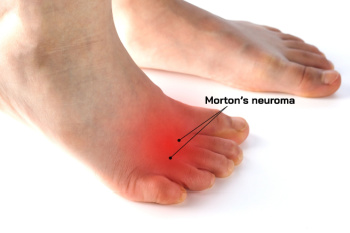Connect With Us
Blog

Bunions are bony protrusions that form at the base of the big toe, causing it to lean inward toward the other toes. Bunions often result from a combination of genetic factors, wearing improper footwear, and structural issues in the foot. As the bunion develops, it can lead to pain, inflammation, and difficulty with shoe wear. In severe cases, complications such as bursitis, hammertoes, or even arthritis may arise due to the altered foot mechanics. If you have a bunion that is causing significant discomfort and interfering with your daily activities, it is suggested that you schedule an appointment with a podiatrist who can offer you various treatment options.
If you are suffering from bunion pain, contact David A. Edmonds, DPM of Advanced Podiatry Associates. Our doctor can provide the care you need to keep you pain-free and on your feet.
What Is a Bunion?
Bunions are painful bony bumps that usually develop on the inside of the foot at the joint of the big toe. As the deformity increases over time, it may become painful to walk and wear shoes. Women are more likely to exacerbate existing bunions since they often wear tight, narrow shoes that shift their toes together. Bunion pain can be relieved by wearing wider shoes with enough room for the toes.
Causes
- Genetics – some people inherit feet that are more prone to bunion development
- Inflammatory Conditions - rheumatoid arthritis and polio may cause bunion development
Symptoms
- Redness and inflammation
- Pain and tenderness
- Callus or corns on the bump
- Restricted motion in the big toe
In order to diagnose your bunion, your podiatrist may ask about your medical history, symptoms, and general health. Your doctor might also order an x-ray to take a closer look at your feet. Nonsurgical treatment options include orthotics, padding, icing, changes in footwear, and medication. If nonsurgical treatments don’t alleviate your bunion pain, surgery may be necessary.
If you have any questions, please feel free to contact our offices located in Northampton and Allentown, PA . We offer the newest diagnostic and treatment technologies for all your foot care needs.

A broken ankle, or ankle fracture, occurs when one or more of the bones making up the ankle joint break. This injury often happens due to trauma, such as twisting the ankle during a fall, sports injury, or car accident. Symptoms of a broken ankle include severe pain, swelling, bruising, inability to bear weight, and deformity of the ankle joint. Early intervention by a podiatrist is essential to properly diagnose and treat the fracture. Treatment typically involves immobilization of the ankle with a cast or brace to allow the bones to heal properly. In some cases, surgery may be necessary to realign the bones or stabilize the fracture with hardware. While recovery time varies depending on the severity of the injury, rehabilitation is often recommended to restore strength, flexibility, and function to the ankle joint. If you have sustained an ankle fracture, it is strongly suggested that you schedule an appointment with a podiatrist for proper treatment and rehabilitation, for the best possible outcome with minimal complications.
Broken ankles need immediate treatment. If you are seeking treatment, contact David A. Edmonds, DPM from Advanced Podiatry Associates. Our doctor can provide the care you need to keep you pain-free and on your feet.
Broken Ankles
A broken ankle is experienced when a person fractures their tibia or fibula in the lower leg and ankle area. Both of these bones are attached at the bottom of the leg and combine to form what we know to be our ankle.
When a physician is referring to a break of the ankle, he or she is usually referring to a break in the area where the tibia and fibula are joined to create our ankle joint. Ankles are more prone to fractures because the ankle is an area that suffers a lot of pressure and stress. There are some obvious signs when a person experiences a fractured ankle, and the following symptoms may be present.
Symptoms of a Fractured Ankle
- Excessive pain when the area is touched or when any pressure is placed on the ankle
- Swelling around the area
- Bruising of the area
- Area appears to be deformed
If you suspect an ankle fracture, it is recommended to seek treatment as soon as possible. The sooner you have your podiatrist diagnose the fracture, the quicker you’ll be on the way towards recovery.
If you have any questions, please feel free to contact our offices located in Northampton and Allentown, PA . We offer the newest diagnostic and treatment technologies for all your foot care needs.

Morton's neuroma is a painful condition affecting the ball of the foot, commonly between the third and fourth toes. It occurs when the tissue surrounding a nerve thickens, leading to compression and irritation. High-heeled shoes, tight footwear, repetitive stress, and foot deformities can contribute to its development. Conservative approaches include wearing supportive shoes, using custom-made orthotic inserts, and avoiding activities that exacerbate symptoms. In some cases, corticosteroid injections may provide relief by reducing inflammation and pain. However, if conservative methods fail, surgical removal of the neuroma may be necessary. The outlook for Morton's neuroma is generally positive with appropriate treatment, although recovery times may vary. Prevention strategies involve wearing properly fitted shoes with adequate toe room, maintaining a healthy weight to reduce pressure on the feet, and avoiding activities that put excessive strain on the forefoot. If you have Morton’s neuroma, it is suggested that you see a podiatrist for an accurate diagnosis and tailored treatment.
Morton’s neuroma is a very uncomfortable condition to live with. If you think you have Morton’s neuroma, contact David A. Edmonds, DPM of Advanced Podiatry Associates. Our doctor will attend to all of your foot care needs and answer any of your related questions.
Morton’s Neuroma
Morton's neuroma is a painful foot condition that commonly affects the areas between the second and third or third and fourth toe, although other areas of the foot are also susceptible. Morton’s neuroma is caused by an inflamed nerve in the foot that is being squeezed and aggravated by surrounding bones.
What Increases the Chances of Having Morton’s Neuroma?
- Ill-fitting high heels or shoes that add pressure to the toe or foot
- Jogging, running or any sport that involves constant impact to the foot
- Flat feet, bunions, and any other foot deformities
Morton’s neuroma is a very treatable condition. Orthotics and shoe inserts can often be used to alleviate the pain on the forefront of the feet. In more severe cases, corticosteroids can also be prescribed. In order to figure out the best treatment for your neuroma, it’s recommended to seek the care of a podiatrist who can diagnose your condition and provide different treatment options.
If you have any questions, please feel free to contact our offices located in Northampton and Allentown, PA . We offer the newest diagnostic and treatment technologies for all your foot care needs.

Foot protection is an often overlooked but critical aspect of workplace safety across various industries. Regardless of the job type, from construction sites to office environments, feet are susceptible to many hazards that can lead to injuries and discomfort. In industrial settings, heavy machinery, falling objects, and sharp materials pose significant risks to foot safety. Properly fitted and durable safety footwear can mitigate these dangers by providing impact resistance and shielding against punctures and crush injuries. Even in office settings, where the risks may seem minimal, slips, trips, and falls can result in painful foot injuries. Wearing comfortable and supportive footwear can help prevent these accidents and promote overall well-being during long hours of standing or walking. Employers play a pivotal role in ensuring that appropriate foot protection measures are in place, including providing employees with access to quality safety footwear and enforcing safety protocols. If you are seeking additional information about what type of foot protection to wear for your profession, it is suggested that you consult a podiatrist.
While working on the feet, it is important to take the proper care of them. For more information about working on your feet, contact David A. Edmonds, DPM from Advanced Podiatry Associates. Our doctor will treat your foot and ankle needs.
Working on Your Feet
Standing on your feet for long periods of time can cause stress and pain in your feet. Your whole body may experience change in terms of posture, back pain, bunions, callouses and or plantar warts. There are ways to avoid these conditions with proper foot care, smart choices and correct posture.
Positive Changes
Negative heeled shoe – Choosing this shoe type places the heel slightly lower than the ball of the foot. These are great for overall foot health. Find shoes that fit you correctly.
Go barefoot – Our feet were not designed to be enclosed for all hours of the day. Try to periodically expose your feet to air.
Eliminate Pain
Foot Exercises – Performing simple exercises, incorporating yoga and doing stretches are beneficial. This will allow increased blood flow to the area and muscles of the foot.
Achilles tendon – Stretching the foot out flat on the floor will relax the calf muscles and tendon. These exercises can be performed almost anywhere. Make sure you add these exercises to your daily regimen.
With a little bit of this information and knowing more about foot health, you will notice changes. Foot stretches and proper footwear will help with pain and prevent further issues.
If you have any questions please feel free to contact our offices located in Northampton and Allentown, PA . We offer the newest diagnostic and treatment technologies for all your foot and ankle needs.
